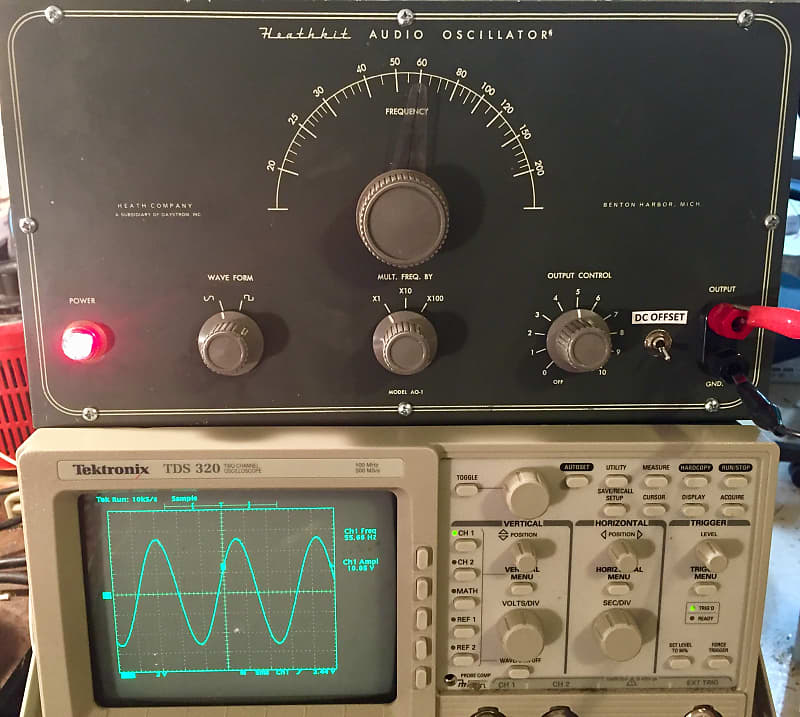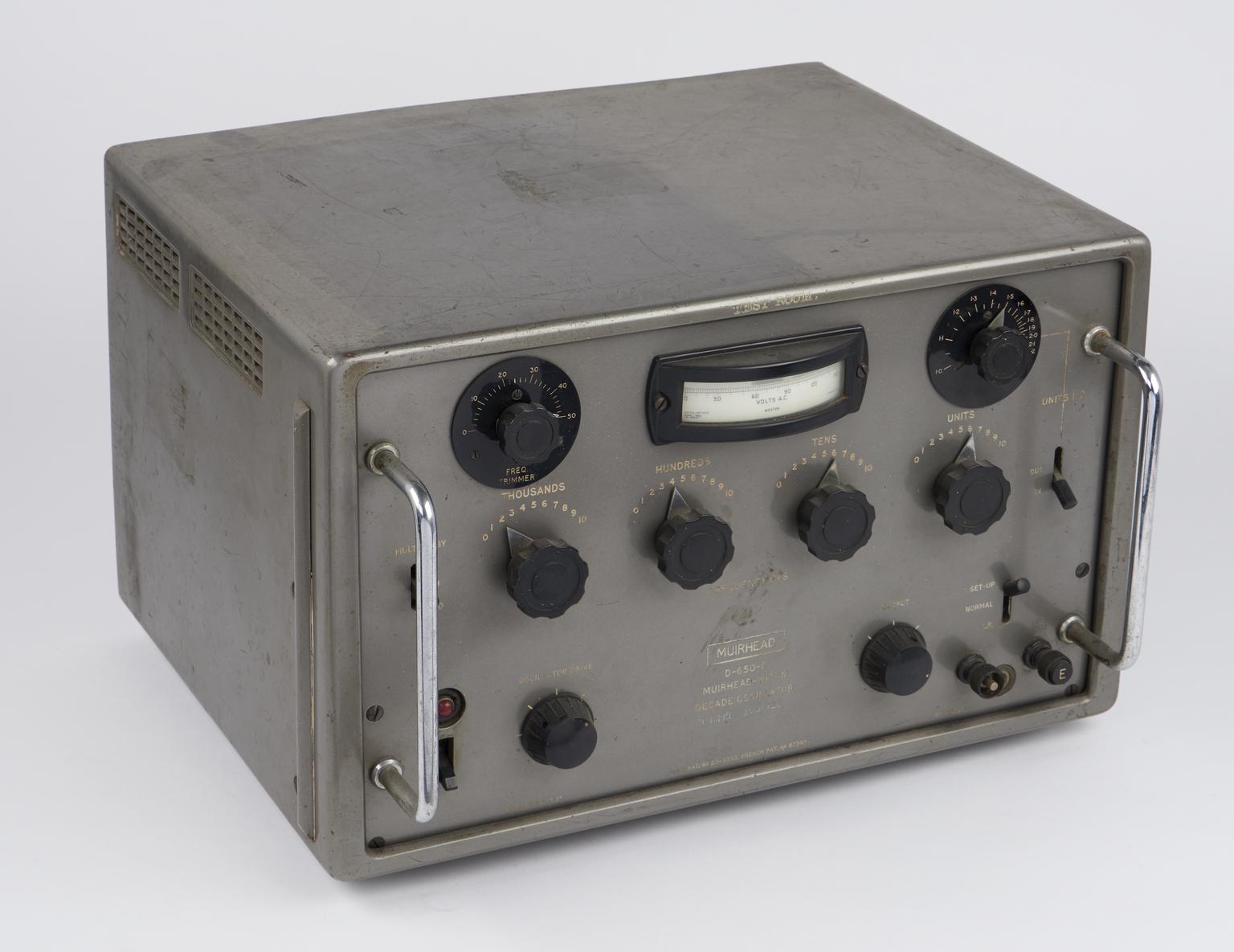The plot line charting the emergence of electronic music is a sequence of small increments up to the mid-20th century. At which point there's a step change—and not only because of the emergence of the magnetic tape recorder. At the same time, electronic music pioneers embraced a more prosaic piece of electronic equipment: the audio test oscillator.

In electronic music, the tape recorder was adapted from its primary purpose (recording sound) to a new one (manipulating sound). The test oscillator was reimagined in a similar way.
Test oscillators typically generate a sine wave, the frequency or pitch of which is controlled by a large rotary dial, and they are designed to measure the response of electrical circuits. They're often used with oscilloscopes, where you put the wave through a piece of kit and see what comes out the other end.
However, once sonic explorers cottoned on to the musical potential of an infinitely variable tone, the test oscillator became a preferred sound source, one that could be manually "played," by turning the dial, and processed, through tape editing and filters. And in the years after the end of World War II, there was a glut of military-surplus oscillators. So they were going cheap.
As is often the way at the intersection of music and technology, lots of people had similar ideas at the same time. The founding figures of British electronic music, Tristram Cary and Daphne Oram, were both born in 1925. Both attended private schools, and both showed some early musical promise. And by the end of World War II, both were ruminating on the possibilities of electronic sound in music.
In 1943, Oram started worked at the BBC as a junior studio engineer and music balancer. That same year, Cary joined the Navy as a radar operator. Both jobs involved using test oscillators. Cary left the Navy in 1946 and began building "the Machine," a ragbag of gadgets mounted on an old table and intended to make electronic music. In time, it would incorporate a disc-cutting lathe, which he bought with his demobilization pay, and a collection of military-surplus oscillators.
From the late '40s, news of the experiments in musique concrète in Paris and then elektronische musik in Cologne began to filter through to London. Pierre Schaeffer in Paris held to the principle of manipulating "real" sounds using disc-cutting lathes and tape.
Karlheinz Stockhausen studied with Schaeffer in 1952 and learned tape-editing techniques before moving to Cologne in '53 to work at the newly established Studio for Electronic Music of the West German Radio in Cologne. Here, the favored audio raw material was electronically created sound, and the proposed sources were two early instruments, the Monochord and the Melochord. Stockhausen thought them limiting and advocated using oscillator sine waves as compositional building blocks, demonstrating his approach with Studie I and Studie II in 1953 and '54.
In the UK, Oram in particular looked on in envy, as the Paris and Cologne studios were located in and funded by state radio stations. It took a while for the BBC to catch up. Gradually, though, whispers from the electronic future were heard over the airwaves. In 1955, Cary soundtracked a BBC radio play, The Japanese Fisherman, with manipulated percussive hits and oscillator drones, the first electronic score on British radio.
In 1957, Oram used tape recorders, oscillators, and filters to create music for a BBC TV adaptation of Amphitryon 38, by the French dramatist Jean Giraudoux. Broadcast in March the following year, this was the first electronic score on British television. Although palpably alien compared to any music performed on conventional instruments, Oram's score was recognizably musical. Where Cary's Fisherman piece was closer to what we'd now call sound design, Oram extracted an almost woodwind-like melody from the oscillators.
By the time Amphitryon 38 was broadcast, Oram, along with Desmond Briscoe, was lobbying the BBC to set up what would become the Radiophonic Workshop. This opened on April Fools' Day 1958, in Maida Vale, west London, under the leadership of Oram and Briscoe. History doesn't record a comprehensive list of equipment in the workshop when it opened. It's known that Oram and Briscoe acquired assorted tape recorders, turntables, and oscillators from other BBC departments along with a pre-war mixing board from the Royal Albert Hall. Louis Niebur's book Special Sound lists some new equipment bought with a budget of £1,900, including a Muirhead One Decade D-650B Oscillator that cost £313.
Although the Workshop acquired a couple of large electronic keyboard instruments in the early days, oscillators remained its choice source of electronic sound until the late '60s and the arrival of EMS synthesizers. Photos from a few years after the Workshop opened show banks of oscillators controlled by a single-octave keyboard. Delia Derbyshire used an oscillator for the top melody line of her famed Doctor Who theme (1962).

During the same period in the US, popular and serious electronic composers were joining in. Bernard Herrmann used oscillator swoops alongside twin Theremins in the soundtrack to The Day the Earth Stood Still (1951). Composer Pauline Oliveros, later a prime mover in the San Francisco Tape Music Center, deployed oscillators in her early work. Talking to Steve Silverstein toward the end of her life, Oliveros said:
"I made my own way of making electronic music in the late '50s, early '60s, using test equipment—oscillators and patchbays and tape recorders. … I was finding a way to improvise with the electronics. That improvisation system was using difference tones between oscillators. Setting oscillators above the range of hearing and using the difference tones between the oscillators in a tape delay system caused a lot of beat frequencies with the bias of the tape recorder."
Louis and Bebe Barron had started to combine tape manipulation techniques with oscillator tones in the late '40s, though unusually it seems that Louis made their oscillators himself. The couple embarked on several projects with avant-garde film makers before their one mainstream commercial triumph, the score for Forbidden Planet (1956). By then, rock 'n' roll was on the way to becoming the dominant popular music genre, though it was a few years before oscillators found their place amid the electric guitars, basses, and drum kits.
Paul Tanner was a session trombonist who'd played for Frank Sinatra. In a 1958 film soundtrack session, he witnessed a Thereminist struggling to pitch his instrument to the orchestra. This prompted Tanner to fashion a home-made instrument he called the electro-theremin. It was simply a test oscillator in a box with a manual slider, with notes marked on the box as a guide.
Tanner used his gadget for TV themes and various sessions. And then, famously, he got a call from Brian Wilson. This led to Tanner appearing on several Beach Boys songs, including "Good Vibrations" (1966). Around the time "Good Vibrations" was released, The Rolling Stones were recording Between The Buttons. The UK edition featured Brian Jones turning the dial of a test oscillator over a Bo Diddley rhythm on "Please Go Home." A year later, Brian was pulling the same trick on the Satanic Majesties album.
The Beach Boys and the Stones were just two examples of a trend at the time, when rock musicians went questing for new sounds—including, but not limited to, electronic sound. In the US in particular, this experimental drive gave rise to several underground bands who moved far closer to an entirely electronic approach than any contemporaneous mainstream acts. These included The United States of America, Fifty Foot Hose, and Silver Apples. What all these bands had in common was a reliance on one-off, hand-built oscillator-based instruments.
Silver Apples, a duo comprising Danny Taylor and Simeon Coxe, took this further than anyone. Taylor was the drummer, while Coxe manned what the sleevenotes to the band's debut described as "nine audio oscillators piled on top of each other and 86 manual controls to control lead, rhythm, and bass pulses with hands, feet, and elbows." This eccentric creation had no piano-style keyboard. Instead, Coxe triggered the oscillators through a selection of telegraph keys and foot pedals. It grew over time, too, with Coxe adding more oscillators and effects units and housing the lot in a collection of custom-made cabinets.
Silver Apples was a going concern for a few years, touring America and releasing two albums, while never achieving commercial success. Their highest-profile appearance was a concert celebrating the Apollo 11 moon landings in New York City's Central Park. But by then, Coxe's oscillator monster was an anachronism. Moog and EMS were trading.
Within a few years, you could choose from several decent synths for the price of a Telecaster. This put paid to what was—with hindsight—the first age of electronic music. Tape editing and oscillators passed out of mainstream practice, in both serious and popular music. Silver Apples split in 1970. When Coxe reformed the band decades later he had a more sensible rig, using contemporary technology, with one or two test oscillators for old times' sake.
These days, test oscillators are rarely used musically, and chances are if you hear a retro manipulated sine wave that sounds like it could have come from an oscillator, it's actually a hardware or software synth. But Nicolas Bernier keeps the flame burning with The Ensemble d'oscillateurs (The Oscillator Ensemble). Inspired by the likes of Oliveros and Stockhausen, the 10-piece group performs entirely on vintage post-war oscillators. Speaking to Synthtopia in 2018, he said: "With only the frequency and volume as musical parameter, we are exploring ways to compose and improvise with sine waves, and a bit of square waves—nothing else."
About the Author: Mark Brend is an author and a musician. His books The Sound Of Tomorrow (Bloomsbury 2012) and Strange Sounds (Backbeat 2005) explore early electronic music and musical instruments. He lives in Devon, England. More info at www.minutebook.co.uk.
